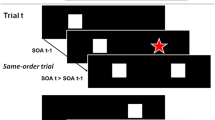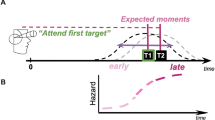Abstract
The production of accurate motor actions requires successful extraction of relevant information about the target of that action. By the same token, it also requires the successful exclusion of potentially distracting, irrelevant information. This study sought to determine the impact of transient visual distractions on performance in an anticipatory timing task, in particular the temporal and spatial relationship between distractor and target at which maximal distraction occurs. The results support the notion of a critical temporal and spatial window of distraction which provides insight into the visuomotor processes underlying distraction.


Similar content being viewed by others
References
Baures R, Oberfeld D, Hecht H (2010) Judging the contact-times of multiple objects: evidence for asymmetric interference. Acta Psychol (Amst) 134:363–371
Baures R, Oberfeld D, Hecht H (2011) Temporal-range estimation of multiple objects: evidence for an early bottleneck. Acta Psychol (Amst) 137:76–82
Benguigui N, Ripoll H, Broderick MP (2003) Time-to-contact estimation of accelerated stimuli is based on first-order information. J Exp Psychol Hum Percept Perform 29:1083–1101
Boot WR, Kramer AF, Peterson MS (2005) Oculomotor consequences of abrupt object onsets and offsets: onsets dominate oculomotor capture. Percept Psychophys 67:910–928
Borst JP, Taatgen NA, van Rijn H (2010) The problem state: a cognitive bottleneck in multitasking. J Exp Psychol Learn Mem Cogn 36:363–382
Brown SW (1985) Time perception and attention—the effects of prospective versus retrospective paradigms and task demands on perceived duration. Percept Psychophys 38:115–124
Brown SW (1995) Time, change, and motion—the effects of stimulus movement on temporal perception. Percept Psychophys 57:105–116
Brown SW, Stubbs DA (1992) Attention and interference in prospective and retrospective timing. Perception 21:545–557
Buhusi CV, Meck WH (2009) Relative time sharing: new findings and an extension of the resource allocation model of temporal processing. Philos Trans R Soc Lond B Biol Sci 364:1875–1885
Carrozzo M, Moscatelli A, Lacquaniti F (2010) Tempo rubato: animacy speeds up time in the brain. PLoS ONE 5
Casini L, Macar F (1997) Effects of attention manipulation on judgments of duration and of intensity in the visual modality. Mem Cognit 25:812–818
Casini L, Macar F (1999) Multiple approaches to investigate the existence of an internal clock using attentional resources. Behav Process 45:73–85
Champagne J, Fortin C (2008) Attention sharing during timing: modulation by processing demands of an expected stimulus. Percept Psychophys 70:630–639
Chaston A, Kingstone A (2004) Time estimation: the effect of cortically mediated attention. Brain Cogn 55:286–289
Cloete SR, Wallis G (2009) Limitations of feedforward control in multiple-phase steering movements. Exp Brain Res 195:481–487
Cole GG, Kentridge RW, Gellatly AR, Heywood CA (2003) Detectability of onsets versus offsets in the change detection paradigm. J Vis 3:22–31
Cosman JD, Vecera SP (2009) Perceptual load modulates attentional capture by abrupt onsets. Psychon Bull Rev 16:404–410
Creelman CD (1962) Human discrimination of auditory duration. J Acoust Soc Am 34:582–593
DeLucia PR, Liddell GW (1998) Cognitive motion extrapolation and cognitive clocking in prediction motion tasks. J Exp Psychol Hum Percept Perform 24:901–914
DeLucia PR, Novak JB (1997) Judgments of relative time-to-contact of more than two approaching objects: toward a method. Percept Psychophys 59:913–928
Dessing JC, Peper CE, Bullock D, Beek PJ (2005) How position, velocity, and temporal information combine in the prospective control of catching: data and model. J Cogn Neurosci 17:668–686
Fischer B, Breitmeyer B (1987) Mechanisms of visual attention revealed by saccadic eye movements. Neuropsychologia 25:73–83
Gibbon J (1977) Scalar expectancy-theory and webers law in animal timing. Psychol Rev 84:279–325
Goodale MA, Milner AD (1992) Separate visual pathways for perception and action. Trends Cognit Sci 15:20–25
Hazeltine E, Helmuth LL, Ivry RB (1997) Neural mechanisms of timing. Trends Cognit Sci 1:163–169
Kahneman D (1973) Attention and effort. Prentice Hall, New York
Kerzel D (2003) Attention maintains mental extrapolation of target position: irrelevant distractors eliminate forward displacement after implied motion. Cognition 88:109–131
Khan MA, Lawrence G, Fourkas A, Franks IM, Elliott D, Pembroke S (2003a) Online versus offline processing of visual feedback in the control of movement amplitude. Acta Psychol (Amst) 113:83–97
Khan MA, Lawrence GP, Franks IM, Elliott D (2003b) The utilization of visual feedback in the control of movement direction: Evidence from a video aiming task. Mot Control 7:290–303
Koch G, Oliveri M, Torriero S, Salerno S, Lo Gerfo E, Caltagirone C (2007) Repetitive TMS of cerebellum interferes with millisecond time processing. Exp Brain Res 179:291–299
Koch G, Oliveri M, Caltagirone C (2009) Neural networks engaged in milliseconds and seconds time processing: evidence from transcranial magnetic stimulation and patients with cortical or subcortical dysfunction. Philos Trans R Soc Lond B Biol Sci 364:1907–1918
Land MF (2006) Eye movements and the control of actions in everyday life. Prog Retin Eye Res 25:296–324
Land MF (2009) Vision, eye movements, and natural behavior. Vis Neurosci 26:51–62
Land MF, McLeod P (2000) From eye movements to actions: how batsmen hit the ball. Nat Neurosci 3:1340–1345
Lavie N, De Fockert J (2005) The role of working memory in attentional capture. Psychon Bull Rev 12:669–674
Lee DN (1976) A theory of the visual control of braking based on information about time-to-collision. Perception 5:437–459
Lewis PA, Miall RC (2003) Distinct systems for automatic and cognitively controlled time measurement: evidence from neuroimaging. Curr Opin Neurobiol 13:250–255
Lyon DR, Waag WL (1995) Time course of visual extrapolation accuracy. Acta Psychol (Amst) 89:239–260
Macar F, Grondin S, Casini L (1994) Controlled attention sharing influences time-estimation. Mem Cognit 22:673–686
Marinovic W, Plooy AM, Tresilian JR (2008) The time course of amplitude specification in brief interceptive actions. Exp Brain Res 188:275–288
Marinovic W, Plooy AM, Tresilian JR (2009a) Preparation and inhibition of interceptive actions. Exp Brain Res 197:311–319
Marinovic W, Plooy AM, Tresilian JR (2009b) The time course of direction specification in brief interceptive actions. Exp Psychol 57:292–300
Marinovic W, Plooy AM, Tresilian JR (2009c) The utilisation of visual information in the control of rapid interceptive actions. Exp Psychol 56:265–273
Marinovic W, Plooy AM, Tresilian JR (2010) The effect of priming on interceptive actions. Acta Psychol (Amst) 135:30–37
Marinovic W, Reid CS, Plooy AM, Riek S, Tresilian JR (2011) Corticospinal excitability during preparation for an anticipatory action is modulated by the availability of visual information. J Neurophysiol (Bethesda) 105:1122–1129
Milner AD, Goodale MA (2008) Two visual systems re-viewed. Neuropsychologia 46:774–785
Oberfeld D, Hecht H (2008) Effects of a moving distractor object on time-to-contact judgments. J Exp Psychol Hum Percept Perform 34:605–623
Peper L, Bootsma RJ, Mestre DR, Bakker FC (1994) Catching balls: how to get the hand to the right place at the right time. J Exp Psychol Hum Percept Perform 20:591–612
Teasdale N, Bard C, Fleury M, Young DE, Proteau L (1993) Determining movement onsets from temporal series. J Mot Behav 25:97–106
Todd JT (1981) Visual information about moving objects. J Exp Psychol Hum Percept Perform 7:795–810
Treisman M, Faulkner A, Naish PL, Brogan D (1990) The internal clock: evidence for a temporal oscillator underlying time perception with some estimates of its characteristic frequency. Perception 19:705–743
Treisman M, Faulkner A, Naish PL (1992) On the relation between time perception and the timing of motor action: evidence for a temporal oscillator controlling the timing of movement. Q J Exp Psychol A 45:235–263
Tresilian JR (1995) Perceptual and cognitive processes in time-to-contact estimation: analysis of prediction-motion and relative judgment tasks. Percept Psychophys 57:231–245
Tresilian JR (1999) Visually timed action: time-out for ‘tau’? Trends Cognit Sci 3:301–310
Tresilian JR (2005) Hitting a moving target: perception and action in the timing of rapid interceptions. Percept Psychophys 67:129–149
Tresilian JR, Houseman JH (2005) Systematic variation in performance of an interceptive action with changes in the temporal constraints. Q J Exp Psychol A 58:447–466
Tresilian JR, Plooy AM (2006) Effects of acoustic startle stimuli on interceptive action. Neuroscience 142:579–594
Tresilian JR, Wallis GM, Mattocks C (2004) Initiation of evasive manoeuvres during self-motion: a test of three hypotheses. Exp Brain Res 159:251–257
Tresilian JR, Plooy AM, Marinovic W (2009) Manual interception of moving targets in two dimensions: performance and space-time accuracy. Brain Res 1250:202–217
Tse PU, Intriligator J, Rivest J, Cavanagh P (2004) Attention and the subjective expansion of time. Percept Psychophys 66:1171–1189
Tyldesley DA, Whiting HTA (1975) Operational timing. J Hum Mov Stud 1:172–177
Vishton PM, Reardon KM, Stevens JA (2010) Timing of anticipatory muscle tensing control: responses before and after expected impact. Exp Brain Res 202:661–667
Watts RG, Bahill AT (1990) Keep your eye on the ball: the science and folklore of baseball. Freeman, New York
Welsh TN, Elliott D (2004) Movement trajectories in the presence of a distracting stimulus: evidence for a response activation model of selective reaching. Q J Exp Psychol A 57:1031–1057
Welsh TN, Elliott D (2005) The effects of response priming on the planning and execution of goal-directed movements in the presence of a distracting stimulus. Acta Psychol (Amst) 119:123–142
Welsh TN, Elliott D, Weeks DJ (1999) Hand deviations toward distracters—evidence for response competition. Exp Brain Res 127:207–212
Zago M, McIntyre J, Senot P, Lacquaniti F (2009) Visuo-motor coordination and internal models for object interception. Exp Brain Res 192:571–604
Zago M, Iosa M, Maffei V, Lacquaniti F (2010) Extrapolation of vertical target motion through a brief visual occlusion. Exp Brain Res 201:365–384
Zakay D, Block RA (1997) Temporal cognition. Curr Dir Psychol 6:12–16
Acknowledgments
We thank Dr. Paul E. Dux for the discussion of the results, Dr. David Lloyd for assistance with Fig. 1 and Alanna Cresp for assistance with data collection. We also appreciate the constructive criticism provided by Dr. Digby Elliott and two anonymous reviewers on an earlier version of this manuscript.
Author information
Authors and Affiliations
Corresponding author
Rights and permissions
About this article
Cite this article
Marinovic, W., Wallis, G. Visual attention affects temporal estimation in anticipatory motor actions. Exp Brain Res 212, 613–621 (2011). https://doi.org/10.1007/s00221-011-2772-2
Received:
Accepted:
Published:
Issue Date:
DOI: https://doi.org/10.1007/s00221-011-2772-2




